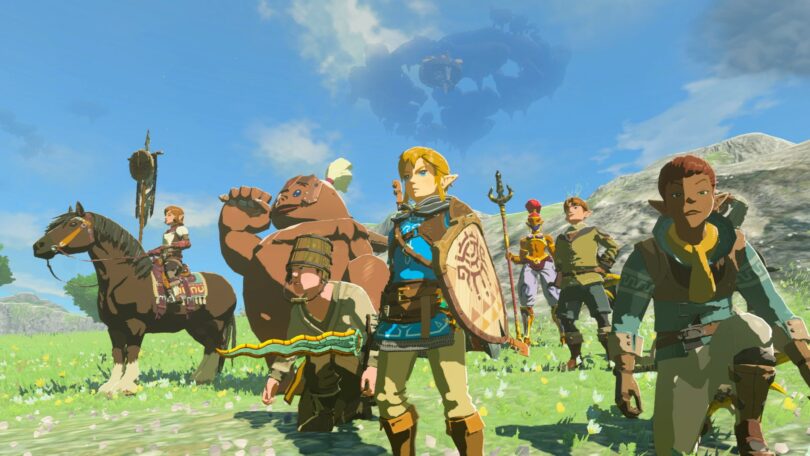Like Minecraft, players must brave these depths for precious materials, and, like Minecraft, they must contend with vicious enemies. Down here are poisoned versions of Hynoxes and Lynels, and other nasty new things not to be spoiled. This place feels built for combat, a proving ground governed by a limited heart pool. If an enemy hits Link or he stands on the Gloom, his heart is permanently erased until he returns to a checkpoint. He is not able to simply eat 4,000 apples and go on.
Without a doubt, the depths will prove the most divisive aspect of Tears. Some will love scaling its vast dark cliffs for new fights. Some will stay above the surface—away from the sterile darkness.
To traverse these new lands, Nintendo has mimicked the tricks of their most loyal fans. BOTW players on YouTube have become infamous for their homebrew flying, driving, and sailing machines. Nintendo supercharges that dream here with Ultrahand, a power that allows players to glue rockets, fire hydrants, wheels, fans, control sticks, mirrors, time bombs, and a litany of other objects together to create whatever their minds can conjure.
Long term, this will be where Tears will look most different to Breath. The truly creative will make things as yet undreamed of; the mildly creative will make soaring hovercrafts and balloons and rockets, rumbling jeeps and old-timey horse-drawn carts. And the creatively bankrupt, like me, will glue 10 logs together over and over again for a magnificent log centipede suitable for each and every obstacle.
Occasionally fiddly controls are alleviated by an auto-build feature, which lets you save schematics to instantly conjure old creations. The ridiculous depth of the sandbox here feels like a call to creators in the streaming era—people are still making BOTW content years later; this game is designed to mushroom that participation.
If the primary emotion Breath instilled was the awe of exploring a new land, here it is the nostalgia of revising an old one. It feels like returning after many years of travel to find that a relative has renovated your beloved home (and added two extra wings to your house). You can quite literally navigate using the old map of BOTW, but time and the cataclysm have reshaped Hyrule. Kakariko village has been bombarded by ruins; a corporate mining company has taken over Death Mountain. Mazes have lifted up into the sky; a network of new caves pockmark the land.
But Breath’s same basic structure remains. You must return to Rito Village, Zora’s Domain, Gerudo Town, and Death Mountain, now beset by natural disasters. The Gorons have become addicted to a mind-altering rock; the Gerudo forced underground by monster-bearing sandstorms. The Zora’s shiny palace is glooped by sludge; Rito is beset by typhoons and snow. In each case, these disasters are presaged by the appearance of Zelda. The story here is more substantial—though still told with some flashbacks.
The maligned Divine Beasts, and their copy-paste bosses, are gone, in favor of more traditional Zelda-style temples—Wind, Fire, etc.—and unique fights. These temples are an interesting mix of new and old, and aesthetically far more interesting—whether they be minecart fire mazes or windborne longboats—but a similar design as the Divine Beasts. Fans of ”traditional” Zelda temples will be happier but not sated. (This could be said about a lot of the game.) Open plan dungeons are the faustian pact of the open world: You can still tackle these temples in largely the order you choose, inevitable for a character who can explode through ceilings. Traditional Zelda dungeon rooms live on in shrines.
As a relentless collectathon, this Zelda reminded me of old Rareware games, but it importantly adds new motivation to anchor combat and harvesting. Fruits can now be attached to arrows to create elemental damage. A Bokoblin boss will drop a horn that will improve your weapon’s damage by a huge amount; a simple broadsword can be encrusted with Hinox bones. Swords last far longer now, once fused, though they do still break. Legendary weapons, like the Biggoron sword, can be repurchased for the high price of poes, tiny blue flames dotted across the dark world.





